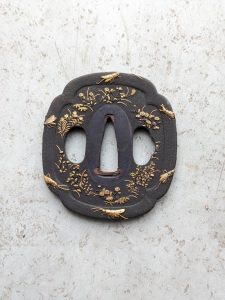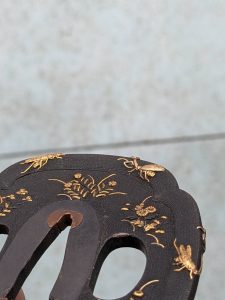実用品から芸術品へ(愛知県名古屋市千種区姫池通 骨董買取 古美術風光舎)
2024.11.10
皆さまこんにちは。スタッフHでございます。
最近は体が無性に温かい飲み物を欲します。いっそのこと白湯でもいいのでとにかく体の中から温めたい衝動が止みません。最近は大好物の珈琲よりも頂き物の「蓮の花茶」をよく飲んでいます。実は珈琲は体を冷やすようですね。体は正直です。
さて本日、目を凝らして眺めておりますのは、緻密な装飾が施された刀鍔でございます。


可憐な草花の周囲にカマキリやバッタなどの虫の象嵌が施されており、どれも生き生きとしていて今にも動き出しそうです。私は割と虫好きなので平気なのですが、虫嫌いの方はたじろいでしまうのではないかと思うほどの精巧な出来栄えです。
更にもはや肉眼では確認できないのですが、写真に撮ってみると「たがね」と呼ばれる細かい粒がびっしりと一面にに彫られています。一つずつ全て手作業で彫刻されているようで人間業とは思えません。職人のプライドと美意識の高さに感服いたします。
鍔は元々は刀身と柄の間に取り付けられ、相手の刀から手を保護したり、自らの刀身へと手を滑らせてしまうことを防ぐという目的の他に、刀の重心を調節するという役割もあるようです。このように元々は実用品として生まれた鍔ですが、その後刀剣の様式が変わっていくのに伴い多様な変化を遂げ発展したと言われています。
手を保護していた実用品が、いかにしてこの煌びやかで細密な装飾が施されるまでになったのでしょうか。
鍔は古くは古墳時代から存在していたようですが、このころはまだ実用的な刀の部品でしかありませんでした。
平安時代後期になると日本独自の刀剣が発達し「太刀」が生まれ、鍔が重要な刀装部品と考えられるようになっていきます。
鎌倉時代はまだ装飾性よりも実用性を重視した鍔が多く見られますが、室町時代になると「打刀(うちがたな)」が主流となります。
打刀とは一般的に「日本刀」と呼ばれる刀剣で、馬上で使用することを目的とした「太刀」よりも短くて軽量であるため、主に徒歩による戦いで活躍しました。刃長は約60㎝以上で刀身の反りが浅いのが特徴で、刃を上に向けた状態で腰に差すため、抜く動作からそのまま斬ることができるという利点があったのだとか。やはり刀の話をしていると、どこかぞわっとしてしまいますね。
使いやすく装備も簡単な打刀は人気となり、刀匠や甲冑師が打刀に合わせて実用的な素朴な鉄鍔を作るようになりました。その一方で足利将軍に仕えていた金工の正阿弥一門が透かしの文様を施した鍔や、金を多用した鍔などの独自の鍔を生み出しました。
安土桃山時代になると南蛮貿易などの影響などもあり、装飾性の高い鍔が作られるようになりました。鍔に用いる図柄や構図、地金や象嵌に用いる金属なども多様化し、それまでの簡単な透かし図案のものだけでなく、「金家」などによる絵画的な美を加えた鍔が現れます。また足利義政の側近として仕えた後藤祐乗を祖とする「後藤家」が、美濃金工の様式を更に格調高いものとした後藤風を確立し、装剣金具の様式の基礎となったとされています。
更に江戸時代に入り、荒々しい気風も廃れていき、刀装にも制約が加えられ、様式の自由度が失われた半面、限られた様式内で様々な技術が発達し、技巧を駆使する名工が生まれました。刀は実用品から権威の象徴や美術品といった意味合いが強くなり、それに伴い鍔も芸術的に発展していきました。
刀匠は減っていきましたが、それに代わり町彫と呼ばれる金工から多くの名工が生まれたとされています。元禄以降幕末に至るまでの時期、多くの鍔工が技術を競い合い、鍔の歴史の最も華やかな時代とも言われています。
日本独自の芸術品、あまり縁のない世界でしたが興味がむくむくと湧いてまいりました。
それでは、また次の機会に。
Hello everyone. This is Staff H.
Recently, my body has been craving for a warm drink. I can’t stop the urge to warm up my body from the inside, even if it is just a cup of white water. Recently, I often drink “lotus flower tea,” which I received from a friend, rather than coffee, which I like very much. In fact, coffee seems to cool the body. My body is honest.
Today, I am looking at a sword tsuba with intricate decoration.
Insects such as praying mantis and grasshoppers are inlaid around the pretty flowers and grasses, and they all look so lifelike that they seem to be ready to move at any moment. I am an insect lover, so I am fine with it, but I think those who do not like insects might flinch at the elaborate workmanship.
Furthermore, although you can no longer see them with the naked eye, when you take a picture of them, you can see that fine grains called “taganes” are carved all over the surface. It seems to have been carved one by one by hand, and it is hard to believe that this is a human work. We are impressed by the pride and aesthetic sense of the craftsman.
The tsuba was originally attached between the blade and the hilt to protect the hand from the opponent’s sword and to prevent the hand from slipping into the blade of the sword. The tsuba was originally created as a practical item, but it is said to have undergone a variety of changes and developments as sword styles changed.
How did this utilitarian item, which protected the hand, come to be decorated with such glittering and detailed ornaments?
Tsubas seem to have existed as far back as the Kofun period (burial mounds), but at that time they were still only practical sword parts.
In the late Heian period (794-1185), Japan developed its own swords and the “Tachi” sword was born, and the tsuba came to be considered an important part of sword accessories.
In the Kamakura period, tsubas were still more practical than decorative, but by the Muromachi period, uchigatana became the mainstream.
Uchigatana, generally called “Japanese sword,” was shorter and lighter than the “tachi” sword, which was intended for use on horseback, and thus was mainly used in battles on foot. The length of the blade was over 60 cm, and the shallow warp of the blade was a feature of this type of sword. Talking about swords makes me shudder.
Easy to use and easy to equip, the uchigatana became so popular that swordsmiths and armorers began to make practical, rustic iron tsuba (tsuba) to match the uchigatana. On the other hand, Shoami, a metal worker in the service of the Ashikaga Shogun, created his own unique types of tsubas, such as tsubas with openwork designs and tsubas that used a lot of gold.
In the Azuchi-Momoyama period (1573-1600), highly decorative tsubas came to be made due to the influence of the Nanban trade and other factors. The designs and compositions used for the design, the metal used for the base metal, and the metal used for inlaying became more diverse, and not only the simple openwork designs that had been used until then, but also the pictorial beauty of “Kinka” and other techniques were added to the design of the bridges. The Goto family, whose founder was Goto Sukenori, a close associate of Ashikaga Yoshimasa, established the Goto style, a more prestigious version of the Mino metalworking style, which is said to have become the basis of the sword metalwork style.
In the Edo period (1603-1867), the rough and rugged style of swordsmithing became obsolete, and restrictions were placed on sword mounting, resulting in a loss of stylistic freedom. Swords became less of a utility item and more of a symbol of authority and a work of art, and tsubas also developed in an artistic way.
The number of swordsmiths decreased, but many master craftsmen were born from the goldsmithing known as machibori. During the period from the Genroku era (1688-1704) to the end of the Edo period, many tsubagumi craftsmen competed in their skills, and it is said to be the most glamorous period in the history of tsubagumi.
I have not been familiar with the world of Japanese unique artworks, but my interest has been piqued.
See you next time.
*******************
ご実家の整理やお片付けなどをされている方のご相談などが多くございます。
お片付けなどくれぐれもご無理のないようになさってくださいませ。
風光舎では古美術品や骨董品の他にも絵画や宝石、趣味のお品など様々なジャンルのものを買受しております。
お片付けをされていて、こういうものでもいいのかしらと迷われているものでも、どうぞお気軽にご相談下さいませ。
また風光舎は、出張買取も強化しております。ご近所はもちろん、愛知県内、岐阜県、三重県その他の県へも出張いたします。
まずは、お電話お待ちしております。
愛知県名古屋市千種区姫池通
骨董 買取【古美術 風光舎 名古屋店】
TEL052(734)8444
10:00-17:00 OPEN
#出張買取#骨董#古美術#骨董品#絵画#版画#茶道具#刀剣#彫刻

